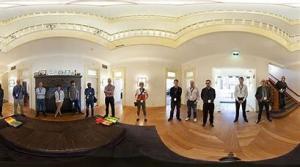
The start of the new season saw an eclectic mix of activities beginning with the customary parade of members eager to show the directions their photography went during the Summer period. The next meeting was a talk by Hugh Gilbert, a seasoned photographer, whose career began as an assistant to a fashion photographer in the Kings Road, in Chelsea. From there he moved on to photographing the work of a colony of artists in studios in St Katherine's Dock, opposite the Tower of London. The slides went to a registry that provided images for exhibition sites including in berlin and Northern Ireland. From there he taught at the Royal College of Art, from where after raising huge sums of money he and a colleague were sacked to avoid upsetting the academic establishment. Providing photographs of Parham House's artefacts for image libraries provided a new activity which is technically rigorous but also satisfying and rewarding. The Garrick Club is another venue where the artwork needs to be photographed. He believes that it is important to see images of paintings in their frames. The RAC also uses him to photograph their artwork including a huge mural that had to be photographed in three parts and stitched together digitally. The skills learned were also applied to the photographing of a copy of the Atlas Maior of 1665. The client wanted a 2.4 metre enlargement of one of the maps. It was too valuable to be taken to his studio so he did the work in situ. He explained how he used a colour balance device to get the colours absolutely right. It took 18 photographs stitched together to produce the final work. Another challenging task was to recreate a Rolling Stones album cover image, the digital rights to which were no longer available to the photographer, from a series of original negatives discarded in the initial selection. After scanning and colour matching individual images Hugh managed to assemble individual elements of the image into a composite photograph that the client copies of which he sold for $30,000 a piece. He then turned to photographing artists' studios in panoramic format ie 18 photos each with three levels of exposure to form a circle and then turned into a panorama using digital software. He showed us a number of examples. The availability of drones brought new opportunities both to photograph the tops of buildings but also to collect panoramic views of River Thames locations across multiple floors of buildings so that the selling company could illustrate accurately the view from the exact apartment that was being illustrated in a sales brochure. All in all this was a very interesting illustration of multi-faceted photography conducted by a consummate professional.
The second meeting was meant to include two speakers but one became unavailable and his colleague Jane Kearney DPAGB agreed to deliver both presentations. Jane is a member of the F8 group related to southwest England counties. Creativity was Jane's topic that stemmed from her rather naive introduction to a camera club. She eventually developed her own style to create images that not all photographers appreciate - abstracts, well known to the author of this piece, were one genre. More prolific though were her images that developed from landscape photographers from a Light Tree in the dark with a red headed model. Distorted flamingos and water drop photography followed some with high speed and psychedelic photography. Her inspiration was Casey Allan who says, "Photoshop is not a crime." Most of her photos have different elements merged together. Some reflect the style of Jane Lazenby with models in medieval clothing portrayed in interesting locations. She likes adding items of detail - one included metal nuts and an umbrella in the rain standing on a rock. Fairy tales also feature. Even air shows provide inspiration and she showed a helicopter in front of an inferno just like a battle scene. Her DPAGB distinction was won with a series of photographs largely in this creative style.
Jane also likes wildlife photography, going out in all weathers on her farm inside a wildlife tent she had manufactured. Afternoon sunlight produced foxes and kingfishers despite the arcane rules. Colourful birds and fighting woodpeckers were early displays. Puffins on Skomer especially at night produce amazing images. The Falklands also provided locations for imperial shag and penguins and pelicans. Costa Rica figured next and hummingbirds were a principal focus, but they moved so fast that you had to anticipate where they would hover to get a shot. Other exotics birds with magnificent tail feathers, toucans, kingfishers, snakes and tree frogs all featured. River swallows inhabited the boat they travelled on.
